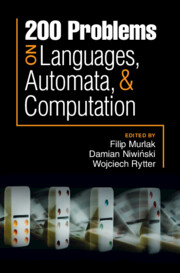Refine search
Actions for selected content:
6950 results in Algorithmics, Complexity, Computer Algebra, Computational Geometry
5 - Words, Numbers, Graphs
- from Part II - Solutions
-
- Book:
- 200 Problems on Languages, Automata, and Computation
- Published online:
- 14 April 2023
- Print publication:
- 20 April 2023, pp 55-64
-
- Chapter
- Export citation
2 - Regular Languages
- from Part I - Problems
-
- Book:
- 200 Problems on Languages, Automata, and Computation
- Published online:
- 14 April 2023
- Print publication:
- 20 April 2023, pp 7-25
-
- Chapter
- Export citation
6 - Regular Languages
- from Part II - Solutions
-
- Book:
- 200 Problems on Languages, Automata, and Computation
- Published online:
- 14 April 2023
- Print publication:
- 20 April 2023, pp 65-128
-
- Chapter
- Export citation
Preface
-
- Book:
- 200 Problems on Languages, Automata, and Computation
- Published online:
- 14 April 2023
- Print publication:
- 20 April 2023, pp vii-viii
-
- Chapter
- Export citation
1 - Words, Numbers, Graphs
- from Part I - Problems
-
- Book:
- 200 Problems on Languages, Automata, and Computation
- Published online:
- 14 April 2023
- Print publication:
- 20 April 2023, pp 3-6
-
- Chapter
- Export citation

200 Problems on Languages, Automata, and Computation
-
- Published online:
- 14 April 2023
- Print publication:
- 20 April 2023
2 - Basic Tools
- from Part I - Preliminaries
-
- Book:
- Random Graphs and Networks: A First Course
- Published online:
- 02 March 2023
- Print publication:
- 09 March 2023, pp 8-26
-
- Chapter
- Export citation
Conventions/Notations
-
- Book:
- Random Graphs and Networks: A First Course
- Published online:
- 02 March 2023
- Print publication:
- 09 March 2023, pp xi-xiv
-
- Chapter
- Export citation
Author Index
-
- Book:
- Random Graphs and Networks: A First Course
- Published online:
- 02 March 2023
- Print publication:
- 09 March 2023, pp 216-217
-
- Chapter
- Export citation
Acknowledgments
-
- Book:
- Random Graphs and Networks: A First Course
- Published online:
- 02 March 2023
- Print publication:
- 09 March 2023, pp x-x
-
- Chapter
- Export citation
7 - Small Subgraphs
- from Part II - Erdős–Rényi–Gilbert Model
-
- Book:
- Random Graphs and Networks: A First Course
- Published online:
- 02 March 2023
- Print publication:
- 09 March 2023, pp 85-92
-
- Chapter
- Export citation
Subject Index
-
- Book:
- Random Graphs and Networks: A First Course
- Published online:
- 02 March 2023
- Print publication:
- 09 March 2023, pp 218-218
-
- Chapter
- Export citation
5 - Vertex Degrees
- from Part II - Erdős–Rényi–Gilbert Model
-
- Book:
- Random Graphs and Networks: A First Course
- Published online:
- 02 March 2023
- Print publication:
- 09 March 2023, pp 64-77
-
- Chapter
- Export citation
Dedication
-
- Book:
- Random Graphs and Networks: A First Course
- Published online:
- 02 March 2023
- Print publication:
- 09 March 2023, pp v-vi
-
- Chapter
- Export citation
3 - Uniform and Binomial Random Graphs
- from Part II - Erdős–Rényi–Gilbert Model
-
- Book:
- Random Graphs and Networks: A First Course
- Published online:
- 02 March 2023
- Print publication:
- 09 March 2023, pp 29-44
-
- Chapter
- Export citation
Part II - Erdős–Rényi–Gilbert Model
-
- Book:
- Random Graphs and Networks: A First Course
- Published online:
- 02 March 2023
- Print publication:
- 09 March 2023, pp 27-28
-
- Chapter
- Export citation
12 - Network Processes
- from Part III - Modeling Complex Networks
-
- Book:
- Random Graphs and Networks: A First Course
- Published online:
- 02 March 2023
- Print publication:
- 09 March 2023, pp 163-177
-
- Chapter
- Export citation
Part III - Modeling Complex Networks
-
- Book:
- Random Graphs and Networks: A First Course
- Published online:
- 02 March 2023
- Print publication:
- 09 March 2023, pp 125-126
-
- Chapter
- Export citation
13 - Intersection Graphs
- from Part III - Modeling Complex Networks
-
- Book:
- Random Graphs and Networks: A First Course
- Published online:
- 02 March 2023
- Print publication:
- 09 March 2023, pp 178-196
-
- Chapter
- Export citation
10 - Inhomogeneous Graphs
- from Part III - Modeling Complex Networks
-
- Book:
- Random Graphs and Networks: A First Course
- Published online:
- 02 March 2023
- Print publication:
- 09 March 2023, pp 127-153
-
- Chapter
- Export citation
